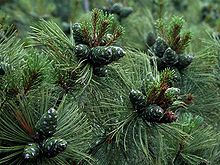| Aven13/Finalsandboxipromise | |
|---|---|

| |
| Scientific classification | |
| Kingdom: | Plantae |
| Clade: | Tracheophytes |
| Clade: | Gymnospermae |
| Division: | Pinophyta |
| Class: | Pinopsida |
| Order: | Pinales |
| Family: | Pinaceae |
| Genus: | Pinus |
| Subgenus: | P. subg. Strobus |
| Section: | P. sect. Quinquefoliae |
| Subsection: | P. subsect. Strobus |
| Species: | P. pumila
|
| Binomial name | |
| Pinus pumila | |
| Synonyms[2] | |
| |

Pinus pumila, commonly known as the Siberian dwarf pine, dwarf Siberian pine,[1][3] dwarf stone pine,[1] Japanese stone pine,[3] or creeping pine,[4] is a tree in the family Pinaceae native to northeastern Asia and the Japanese isles. It shares the common name creeping pine with several other plants. The tree grows to a height of 1–3 m (3–10 ft) in its native habitat. [5]
Description edit
The Siberian dwarf pine is a coniferous evergreen shrub ranging from 1–3 m (3–10 ft) in height, exceptionally up to 5 m (16 ft), but may have individual branches that extend farther along the ground in length. In the mountains of northern Japan, it sometimes hybridises with the related Japanese white pine (Pinus parviflora); these hybrids (Pinus × hakkodensis) are larger than P. pumila, reaching 8–10 m (26–33 ft) tall on occasion.
The leaves are needle-like, formed in bundles of five and are 4–6 cm long. The cones are 2.5-4.5 cm long, with large nut-like seeds (pine nuts).
Distribution edit
The range covers the Far East, Eastern Siberia, north-east of Mongolia, north-east of China, northern Japan and Korea.[3] Siberian dwarf pine can be found along mountain chains, passing the upper forest border, where it forms uninterrupted hard-to-pass thickets, also it grows in the sea bank of the Okhotsk and the Bering Seas, Tatarsk and Pacific coast (the Kurils).
It grows very slowly and is a perennial plant. It can live up to 300 and even 1000 years.[6][full citation needed] For example, in harsh conditions of Siberia region there are trees of Siberian dwarf pine, which are 250 years-old and older.
Cultivation edit
This plant is grown as an ornamental shrub in parks and gardens. The cultivar P. pumila 'Glauca' has gained the Royal Horticultural Society's Award of Garden Merit.[7]
Ecology edit
The seeds are harvested and dispersed by the spotted nutcracker (Nucifraga caryocatactes).
References edit
- ^ a b c Farjon, A. (2013). "Pinus pumila". IUCN Red List of Threatened Species. 2013: e.T42405A2977712. doi:10.2305/IUCN.UK.2013-1.RLTS.T42405A2977712.en.
- ^ a b World Checklist of Selected Plant Families (WCSP). Royal Botanic Gardens, Kew http://wcsp.science.kew.org/namedetail.do?name_id=380284. Retrieved 29 December 2017.
{{cite web}}: Missing or empty|title=(help) - ^ a b c "Aven13/Finalsandboxipromise". Germplasm Resources Information Network. Agricultural Research Service, United States Department of Agriculture.
{{citation}}:|access-date=requires|url=(help) - ^ Fukui, K.; Sone, T.; Yamagata, K.; Otsuki, Y.; Sawada, Y.; Vetrova, V.; Vyatkina, M. (2008). "Relationships between permafrost distribution and surface organic layers near Esso, central Kamchatka, Russian Far East". Permafrost and Periglacial Processes. 19 (1): 85–92. doi:10.1002/ppp.606.
- ^ Wu, Zheng-Yi; Raven, Peter H. (1999). Flora of China. Vol. 4. Missouri Botanical Gardens Press. ISBN 0915279703.
- ^ Koropachinsky, Vstovskaya, 2002
- ^ "RHS Plant Selector - Pinus pumila 'Glauca'". Retrieved 6 February 2021.
External links edit
- Conifers Around the World: Pinus pumila - Hai-Matsu.
- Media related to Pinus pumila at Wikimedia Commons
- Data related to Pinus pumila at Wikispecies
